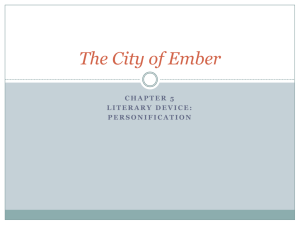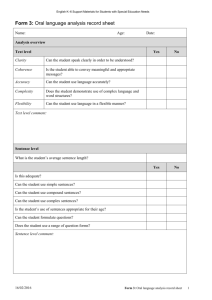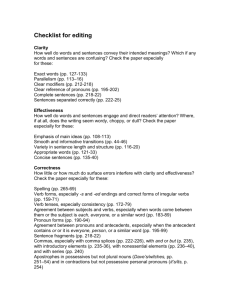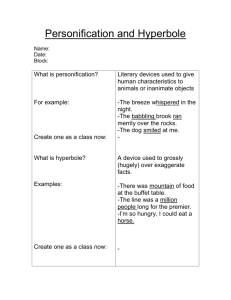Title - Parts of Speech integrated with Computers
advertisement
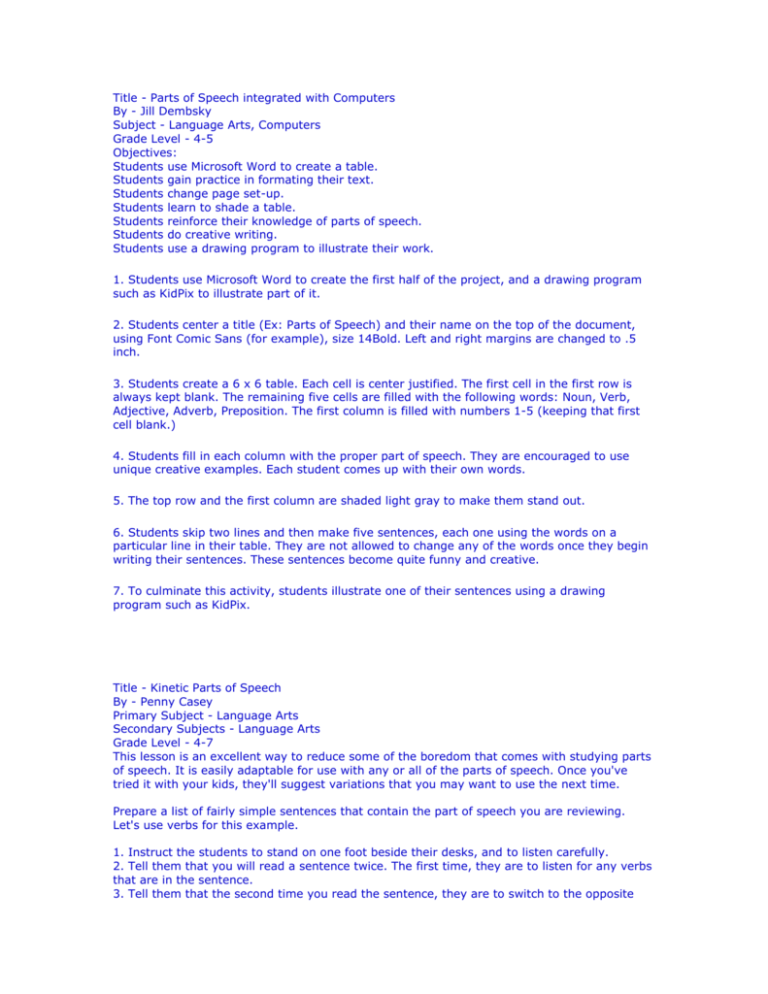
Title - Parts of Speech integrated with Computers By - Jill Dembsky Subject - Language Arts, Computers Grade Level - 4-5 Objectives: Students use Microsoft Word to create a table. Students gain practice in formating their text. Students change page set-up. Students learn to shade a table. Students reinforce their knowledge of parts of speech. Students do creative writing. Students use a drawing program to illustrate their work. 1. Students use Microsoft Word to create the first half of the project, and a drawing program such as KidPix to illustrate part of it. 2. Students center a title (Ex: Parts of Speech) and their name on the top of the document, using Font Comic Sans (for example), size 14Bold. Left and right margins are changed to .5 inch. 3. Students create a 6 x 6 table. Each cell is center justified. The first cell in the first row is always kept blank. The remaining five cells are filled with the following words: Noun, Verb, Adjective, Adverb, Preposition. The first column is filled with numbers 1-5 (keeping that first cell blank.) 4. Students fill in each column with the proper part of speech. They are encouraged to use unique creative examples. Each student comes up with their own words. 5. The top row and the first column are shaded light gray to make them stand out. 6. Students skip two lines and then make five sentences, each one using the words on a particular line in their table. They are not allowed to change any of the words once they begin writing their sentences. These sentences become quite funny and creative. 7. To culminate this activity, students illustrate one of their sentences using a drawing program such as KidPix. Title - Kinetic Parts of Speech By - Penny Casey Primary Subject - Language Arts Secondary Subjects - Language Arts Grade Level - 4-7 This lesson is an excellent way to reduce some of the boredom that comes with studying parts of speech. It is easily adaptable for use with any or all of the parts of speech. Once you've tried it with your kids, they'll suggest variations that you may want to use the next time. Prepare a list of fairly simple sentences that contain the part of speech you are reviewing. Let's use verbs for this example. 1. Instruct the students to stand on one foot beside their desks, and to listen carefully. 2. Tell them that you will read a sentence twice. The first time, they are to listen for any verbs that are in the sentence. 3. Tell them that the second time you read the sentence, they are to switch to the opposite foot each time a verb is read. 4. Be sure to use sentences that contain some helping verbs, so that the students sometimes will have to switch feet more than once during a sentence. Using a physical activity can be varied in any number of ways. For example, this week my seventh graders were reviewing nouns, verbs, and adjectives. When I read a noun, they put their hands on their heads. When I read a verb, they pumped their arms as if they were running. When I read an adjective, they put their hands on their shoulders. Students love this, and they learn from one another as well as from me. E-Mail Penny Casey! Title - Personification By - Debbie Aubert Primary Subject - Language Arts Grade Level - 5-6 Time Frame - 2-3 fifty minute class periods Materials Needed: a copy of the book The Three Little Pigs, handout of sentences using personification (one for each student) Kansas State Reading/Writing Standards Addressed: Reading 6.1.3.5 (identifies and determines meaning of figurative language; Writing 6.1.2.13 (practices selecting words that are suitable and precisely create appropriate imagery) Specific Objectives: The student will: tell what personification is look at given sentences and describe the object being personified write simple sentences using personification Anticipatory Set: Read the book The Three Little Pigs to the students. After reading the story, ask the students to think about the pigs and the wolf and discuss what they do that normal pigs and wolves don’t do. Tell them these are examples of personification. Step by Step Procedure: Day One 1. Read the book The Three Little Pigs to the students as described in the anticipatory set. 2. Write the definition of personification on the board. (Personification is giving human characteristics to everyday ideas, objects, and animals.) 3. Re-examine some of the ideas given during the anticipatory set and ask why they are examples of personification. 4. Pass out the handout of sentences containing examples of personification and have students work in cooperative groups. Tell them to underline the object, animal, or idea being personified. They will circle what they’re doing that makes it an example of personification. 5. Allow time for students to complete this activity, and then go over each sentence asking different students to give the example of personification in each sentence. Step by Step Procedure: Day Two 1. Ask students if they remember the definition of personification from yesterday’s lesson. 2. Begin writing nouns on the chalkboard such as monkey, tree, wind, snow, sky, leaf. Ask students to help you expand this list until you have about 20 nouns on the board. In another column on the board, write some verbs such as whispered, smiled, laughed. Ask students to also help you expand this list until you have about 20 verbs. 3. Tell students that they’re going to write ten of their own sentences using personification. You will write a couple of examples on the board such as: The leaf danced across the sky on its journey away from the tree. 4. Remind them to make use of prepositional phrases, adjective, adverbs, and other parts of speech learned to make their sentences exciting. Let students share their work if they wish to. Independent Practice: Students will write ten sentences as described in Day 2 Step by Step Procedure. Closure: At the end of day 2, ask students if they have any questions about personification. Ask someone to once again give the definition of personification. Ask students if they liked hearing the sentences that their classmates wrote, and then ask them why. Tell them that using figurative language like personification helps to make our writing much more fun to read. Assessment: none required until the end of the figurative language unit Modifications: The number of sentences could be cut down for those students that need modification, as it’s the quality we’re looking for, not the quantity. Other modifications could be made if required by an IEP. Personification Worksheet Name_________________________________ Directions: Underline the idea, object, animal being personified and circle what they’re doing that makes it an example of personification. 1. The sun danced across the sky on the hot summer day. 2. The big full moon guided me through the forest. 3. The mountain listened to the rumbles beneath its surface. 4. As the rain pounded to the ground, everyone ran for cover. 5. The old man sat at the edge of the sea as the waves crashed on the shore. 6. The old car groaned as it made its way down the long open road. 7. The wind whispered lonely sounds as it blew through the old creaky windows. 8. The leaves raced to the ground as the children ran across the playground. 9. The pencil moaned as the boy turned the handle on the pencil sharpener. 10. The tornado pranced across the field and wiped away everything in its path. Title - Tongue Twisters By - Ryla Pollan Primary Subject - Language Arts Grade Level - 3-8 Students not only have fun with this creative writing activity, but they also review several parts of speech! MATERIALS: * pencil and paper METHOD: 1. Start with sharing some well-known tongue twisters with your students. They get really involved as they try to repeat them and share others. Next, challenge your students to write their own tongue twisters. I use this model to get them started: * Nouns - use at least one (Betty) * Verbs - use at least one (bought) * Adjectives - use several (brainy, billion, big, Buicks, black) * Adverbs - use at least one (busily) * Prepositional Phrases - use at least one (by the bay) 2. Using this model, we now have a tongue twister: Brainy Betty busily bought a billion, big, black Buicks by the bay. 3. Have students write several. Let them go through the peer editing process. Then print final copies to display on a bulletin board or put them together for a class book. Title - "Pop Pronouns" By - Laurie Frazier Primary Subject - Language Arts Secondary Subjects - Music Grade Level - 6-8 This is a quick and fun way to review pronouns. After teaching students about personal pronouns, one of the best ways I have found to review them is to have them identify them in songs. I play the song "Eight Days a Week" or "She Loves You" by the Beatles. I have students make a tally mark every time they hear a personal pronoun. The student that gets the correct number wins a small prize such as a homework pass. Another song that works well are "My Girl" by the Temptations. Basically any song that is easy to understand and has an abundance of personal pronouns works well. This activity can be modified for other parts of speech. This is not only a great way to review pronouns, but it is also a great way to reinforce listening skills. Adjective/Adverb "Taboo" by Steve Garcia Grades 9-12 Materials: several slips of paper with simple subject + verb sentences (The child laughed.) This game is played similar to the popular game of "Taboo." Divide class into four equal teams. One member chooses a slip of paper with the sentence written on it. He/she then gives up to 5 adjectives to describe the subject (ex. small, young, cute, fair-haired, or sweet to describe "child"). The team then tries to guess the subject. If they are correct, the team scores 1 point. The clue-giver then gives up to 5 adverbs to describe the verb (ex. happily, humorously, gleefully, sweetly, joyfully to describe "laughed"). If the team guesses correctly, they earn 3 points. If the team misses either the subject or verb, the next team has an opportunity to "steal" the points by having one of their members give one clue. The player is disqualified if he/she gives a noun instead of an adjective or a verb instead of an adverb or gives more than a one-word description. This was a great way for my class to recognize the role of adverbs and adjectives in sentence construction. Lesson Plan #:AELP-GRM0201 Mad Lib An Interactive Internet Lesson An Educator's Reference Desk Lesson Plan Submitted by: Melissa Gassman Endorsed by: Sean Smith, Ph. D., Berea College, Berea, KY Date: January 31, 1998 Grade Level(s): 5 Objectives: Students write using appropriate forms, conventions, and styles to communicate ideas and information to different audiences for different purposes. Subject(s): Language Arts/Grammar Educational Technology Overview: Students will make up "Wacky" stories using what they know about the parts of speech. It is important for students to know the parts of speech in order to write sentences to communicate ideas so that everyone can understand. This will prepare them for writing their own stories and other writing assignments. This lesson will reinforce the parts of speech and how they work in a sentence. Students will type the part of speech that are requested into the blank lines and then click on to see their "Wacky Web Tale". Then students are to print out their favorite tale to hand in. Learning Outcomes For The Lesson: After this lesson students will... - Recognize the difference between a noun, verb, adjective, adverb, exclamations, plural nouns, plural verbs, present and past tense verbs. - Be able to follow directions. Procedure: 1. In an Internet browser go to: http://www.eduplace.com/tales/ pick a tale and click on it. 2. In the blank line with a label to the right of it type in the appropriate word. 3. If you need help click on parts of speech help at the top right hand corner 4. Keep typing the appropriate word in to the end then click on see your wacky web tale 5. Read the tale to see if it is correct . 6. Print you favorite tale and turn it in. Extensions: Have the class write their own mad lib and trade with a classmate to create a wacky tale. Assessment: Students should know the difference between a noun, verb, adjective, adverbs, exclamations, plural nouns, plural verbs, present and past tense verbs. Only the correct part of speech should be in the appropriate box. Have the students print out their final story.
